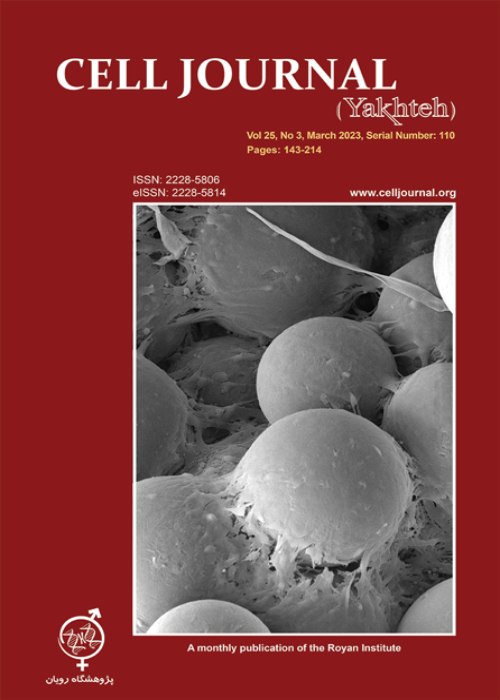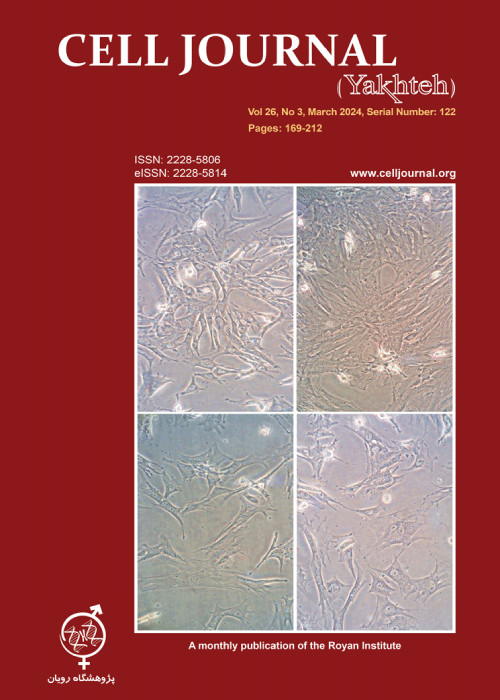فهرست مطالب

Cell Journal (Yakhteh)
Volume:25 Issue: 3, Mar 2023
- تاریخ انتشار: 1401/12/23
- تعداد عناوین: 8
-
-
Pages 143-157
Vitiligo is an auto-immune disease, causing depigmentation of skin in 0.2-1.8% of global population. Topicalcorticosteroids and calcineurin inhibitors are the only treatments with firm evidence of optimal effectiveness withconsiderable side effects. Phototherapies might not induce serious side effects, although the effectiveness of the methodis limited. Advanced therapy medicinal products (ATMPs) are emerging treatment modalities based on correction andreplacement of affected genes, damaged tissues or cells in treatment of difficult-to-treat diseases. Due to optimaleffectiveness and minimal side effects, ATMPs have recently gained much attention in order to develop new treatments.In this review, the ATMPs for treating vitiligo were along with its clinical success, affordability and cost-effectiveness.Currently, the main ATMP based products using in treatment of vitiligo are non-cultured epidermal cell, melanocytes,and hair follicle melanocytes. These products have shown promising results in the non-responding vitiligo patients.Furthermore, mesenchymal stem cells and multi-lineage differentiating stress enduring cells are other new potentialmodalities. Recently, Iranian Food and Drug Administration (IR-FDA) authorized the first cell-based product for vitiligo.This product is autologous suspension of keratinocytes and melanocytes. Although ATMPs are efficient and could becost-effective in long term, the most important obstacle is affordability of them. This could be facilitated by insurancecompanies and instalments payment programs from manufacturers.
Keywords: Cell therapy, Immune System Diseases, Keratinocytes, Melanocytes, Vitiligo -
Pages 158-164
The goal of tissue engineering is to repair and regenerate diseased and damaged tissues and organs with functional and biocompatible materials that mimic native and original tissues which leads to maintaining and improvement of tissue function. Lignin and cellulose are the most abundant polymers in nature and have many applications in industry. Moreover, recently the physicochemical behaviors of lignin and cellulose, including biocompatibility, biodegradability, and mechanical properties, have been used in diverse biological applications ranging from drug delivery to tissue engineering. To assess these aims, this review gives an overview and comprehensive knowledge and highlights the origin and applications of lignin and cellulose-derived scaffolds in different tissue engineering and other biological applications. Finally, the challenges for future development using lignin and cellulose are also included. Plant-based tissue engineering is a promising technology for progressing areas in biomedicine, regenerative medicine, and nanomedicine, with much research focused on the development of newer material scaffolds with individual specific features to make functional and biocompatible tissues and organs for medical applications.
Keywords: Cellulose, Drug Delivery, Lignin, Scaffold, Tissue Engineering -
Pages 165-175Objective
Stress may have an important role in the origin and progress of depression and can impair metabolichomeostasis. The one-carbon cycle (1-CC) metabolism and amino acid (AA) profile are some of the consequencesrelated to stress. In this study, we investigated the Paroxetine treatment effect on the plasma metabolite alterationsinduced by forced swim stress-induced depression in mice.
Materials and MethodsIn this experimental study that was carried out in 2021, thirty male NMRI mice (6-8 weeksage, 30 ± 5 g) were divided into five groups: control, sham, paroxetine treatment only (7 mg/kg BW/day), depressioninduction, and Paroxetine+depression. Mice were subjected to a forced swim test (FST) to induce depression and thenwere treated with Paroxetine, for 35 consecutive days. The swimming and immobility times were recorded during theinterventions. Then, animals were sacrificed, plasma was prepared and the concentration of 1-CC factors and twentyAAs was measured by spectrophotometry and high-performance liquid chromatography system (HPLC) techniques.Data were analyzed by SPSS, using One-Way ANOVA and Pearson Correlation, and P<0.05 was considered significant.
ResultsPlasma concentrations of phenylalanine, glutamate, aspartate, arginine, ornithine, citrulline, threonine,histidine, and alanine were significantly reduced in the depression group in comparison with the control group.The Homocysteine (Hcy) plasma level was increased in the Paroxetine group which can be associated withhyperhomocysteinemia. Moreover, vitamin B12, phenylalanine, glutamate, ornithine, citrulline, and glycine plasmalevels were significantly reduced in the depression group after Paroxetine treatment.
ConclusionThis study has demonstrated an impairment in the plasma metabolites’ homeostasis in depression andnormal conditions after Paroxetine treatment, although, further studies are required.
Keywords: Amino acid, Depression, Mice, Selective serotonin reuptake inhibitor -
Pages 176-183ObjectiveBeta-thalassemia is a group of inherited hematologic. The most HBB gene variant among Iranianbeta-thalassemia patients is related to two mutations of IVSII-1 (G>A) and IVSI-5 (G>C). Therefore, our aim ofthis study is to use the knock in capability of CRISPR Cas9 system to investigate the correction of IVSII-1 (G>A)variant in Iran.Materials and MethodsIn this experimental study, following bioinformatics studies, the vector containingPuromycin resistant gene (PX459) was cloned individually by designed RNA-guided nucleases (gRNAs), andcloning was confirmed by sequencing. Proliferation of TLS-12 was done. Then, the transfect was set up by thevector with GFP marker (PX458). The PX459 vectors carrying the designed gRNAs together with Single-strandedoligodeoxynucleotides (ssODNs) as healthy DNA pattern were transfected into TLS-12 cells. After taking the singlecell clones, molecular evaluations were performed on single clones. Sanger sequencing was then performed toinvestigate homology directed repair (HDR).ResultsThe sequencing results confirmed that all three gRNAs were successfully cloned into PX459 vector. In thetransfection phase, The TLS-12 containing PX459-gRNA/ssODN was selected. Molecular evaluations showed thatthe HBB gene was cleaved by the CRISPR/Cas9 system, that indicates that the performance of non-homologous endjoining (NHEJ) repair system. Sequencing in some clones cleaved by the T7E1 enzyme showed that HDR was notconfirmed in these clones.ConclusionIVS-II-1 (G> A) mutation, which is the most common thalassemia mutation especially in Iran, the CRISPR/Cas9 system was able to specifically target the HBB gene sequence. This could even lead to a correction in themutation and efficiency of the HDR repair system in future research.Keywords: Beta-Thalassemia, Gene therapy, Homology Directed Repair, Non-Homologous End Joining
-
Pages 184-193ObjectiveUmbilical cord blood (UCB) is an accessible and effective alternative source for hematopoietic stemcell (HSC) transplantation. Although the clinical application of UCB transplantation has been increased recently,quantitative limitation of HSCs within a single cord blood unit still remains a major hurdle for UCB transplantation.In this study we used microcarrier beads to evaluate the ex vivo expansion of UCB-derived HSCs in co-culturedwith UCB-derived mesenchymal stem cells (MSC).Materials and MethodsIn this experimental study, we used microcarrier beads to expand UCB-derived MSCs.We investigated the simultaneous co-culture of UCB-derived CD34+ cells and MSCs with microcarrier beads toexpand CD34+ cells. The colony forming capacity and stemness-related gene expression on the expanded CD34+cells were assessed to determine the multipotency and self-renewal of expanded cells.ResultsOur results indicated that the microcarrier-based culture significantly increased the total number and viabilityof UCB-derived MSCs in comparison with the monolayer cultures during seven days. There was a significant increase inthe UCB-derived CD34+ cells expanded in the presence of microcarrier beads in this co-culture system. The expandedUCB-derived CD34+ cells had improved clonogenic capacity, as evidenced by higher numbers of total colony counts,granulocyte, erythrocyte, monocyte, megakaryocyte colony forming units (CFU-GEMM), and granulocyte–monocytecolony forming units (CFU-GM). There were significantly increased expression levels of key regulatory genes (CXCR4,HOXB4, BMI1) during CD34+ cells self-renewal and quiescence in the microcarrier-based co-culture.ConclusionOur results showed that the increase in the expansion and multipotency of CD34+ cells in the microcarrierbasedco-culture can be attributed to the enhanced hematopoietic support of UCB-derived MSCs and improved cell-cellinteractions. It seems that this co-culture system could have the potential to expand primitive CD34+ cells.Keywords: Co-culture, Hematopoietic Stem Cell, Mesenchymal stem cells, Microcarrier
-
Pages 194-202Objective
We investigated whether co-incubation of 5-FU and gum-based cerium oxide nanoparticles (CeO2 NPs) would improve half-maximal inhibitory concentration (IC50) and apoptosis in the Caco-2 cancer cell line
Materials and MethodsIn this experimental study, we synthesized Ceo-2-XG by the nano perception method.X-ray diffraction (XRD), field emission scanning electron microscopy (FESEM), transmission electron microscopy(TEM), dynamic light scattering (DLS) and vibrating sample magnetometer (VSM) techniques were employedto characterize the synthesized nanoparticles. The Caco-2 cancer cells were cultured and treated with Ceo-2-XG and 5-FU. Cytotoxicity analysis was carried out using MTT assay on Caco-2 cancer cells. CXCR1, CXCR2,CXCL8, BAX, BCL-2, P53, CASPASE-3, CASPASE-8 and CASPASE-9 gene expression changes were assessedby quantitative reverse-transcriptase polymerase chain reaction (qRT-PCR). The Caco-2 cancer cell mortalitymechanism was analyzed using Annexin V-FITC/PI flow cytometry. Using the inverted microscope morphologychanges of the Caco-2 cancer cells was observed.
ResultsWith a sample size of roughly 11 nm, TEM analysis revealed spherical structures. Interestingly, after 72hours, 400 μg/ml nanoparticles significantly lowered the IC50 of 5-FU from 101 to 71 μg/ml (P<000.1). Furthermore,qRT-PCR analysis showed that BCL-2, CXCR1, CXCR2 and CXCR8 expressions were significantly decreased inthe 5-FU and Ceo-2-XG nanoparticles co-incubated group, compared to the 5-FU alone (P<0.001). Notably, geneexpressions of BAX, P53, CASPASE-3, CASPASE-8 and CASPASE-9 were significantly higher in the 5-FU and Ceo-2-XG nanoparticles co-incubated group, compared to the 5-FU alone (P<0.001). The findings revealed that dead cellsowing to apoptosis were more than two times higher in 5-FU and Ceo-2-XG nanoparticles cancer cells than in 5-FUalone treated cancer cells.
ConclusionCo-incubation of 5-FU and Ceo-2-XG nanoparticles significantly increased apoptosis in the Caco-2cancer cells. The antiproliferative activity of co-incubated 5-FU and Ceo-2-XG nanoparticles on Caco-2 cancer cellswas substantially higher than that of 5-FU alone.
Keywords: Apoptosis, Caspases, Colorectal Neoplasms, Oncogenes -
Pages 203-211ObjectiveThis study aimed to introduce novel techniques for identifying the genes associated with developingchronic obstructive pulmonary disease (COPD) and to prioritize COPD candidate genes using regression methods.Materials and MethodsThis is a secondary analysis of the data from an experimental study. We used penalizedlogistic regressions with three different types of penalties included least absolute shrinkage and selection operator(LASSO), minimax concave penalty (MCP), and smoothly clipped absolute deviation (SCAD). The models weretrained using genome-wide expression profiling to define gene networks relevant to the COPD stages. A 10-foldcross-validation scheme was used to evaluate the performance of the methods. In addition, we validate ourresults by the external validity approach. We reported the sensitivity, specificity, and area under curve (AUC) ofthe models.ResultsThere were 21, 22, and 18 significantly associated genes for LASSO, SCAD, and MCP models, respectively.The most statistically conservative method (detecting less significant features) was MCP detected 18 genes that wereall detected by the other two approaches. The most appropriate approach was a SCAD penalized logistic regression(AUC= 96.26, sensitivity= 94.2, specificity= 86.96). In this study, we have a common panel of 18 genes in all threemodels that show a significant positive and negative correlation with COPD, in which RNF130, STX6, PLCB1,CACNA1G, LARP4B, LOC100507634, SLC38A2, and STIM2 showed the odds ratio (OR) more than 1. However, therewas a slight difference between penalized methods.ConclusionRegularization solves the serious dimensionality problem in using this kind of regression. More explorationof how these genes affect the outcome and mechanism is possible more quickly in this manner. The regression-basedapproaches we present could apply to overcoming this issue.Keywords: COPD, Gene expression, LASSO, MCP, Panelized Logistic Regression
-
Pages 212-214
Vitiligo is an autoimmune skin disorder that can significantly affect the quality of life in patients. However, currenttreatment strategies such as phototherapy, topical glucocorticosteroids, or systemic immunosuppressants canbe helpful in vitiligo management, and treatments for disease stability which is the main challenge in vitiligomanagement. Novel therapeutic modalities have made promising advances in this regard. Molecular targetedtherapy to target Janus-activated kinase (JAK) such as Tofacitinib and Ruxolitinib in addition to the cell-basedtreatments are innovative therapeutic options, which are recently used for vitiligo treatment. Transplantation ofnon-cultured melanocytes-keratinocytes have been studied in Iran and phase one data published in 2010 on 10patients that continued on 300 patients as phase three in 2018. Cell Tech Pharmed™ Co. registered and appliedthis cell-based product, ReColorCell®, as a GMP certified by Iranian Food and Drug Administration (IR-FDA). On11th December 2021, ReColorCell® officially registered as the first cell-based product in the Iranian drug list (IDL).Currently, the post-market study of this product is ongoing.
Keywords: Cell therapy, Keratinocyte, Melanocyte, Vitiligo


